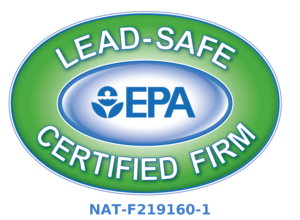Older Homes And Buildings
If your home was built before 1978, it is more likely to have lead-based paint. In 1978, the federal government banned consumer uses of lead-based paint, but some states banned it even earlier
Lead paint is still present in millions of homes, sometimes under layers of newer paint. If the paint is in good shape, the lead paint is usually not a problem. Deteriorating lead-based paint (peeling, chipping, chalking, cracking, damaged, or damp) is a hazard and needs immediate attention.
Lead-based paint may also be a hazard when found on surfaces that children can chew or that get a lot of wear-and-tear, such as:
- Windows and window sills;
- Doors and door frames; and
- Stairs, railings, banisters, and porches.
A few tips to reduce sources of lead exposure in older homes and buildings:
- Inspect and keep all painted surfaces in excellent shape and clean up dust frequently with a wet cloth or paper towel. Read about simple steps to protect your family from lead hazards (PDF).
- Consult a certified lead professional before beginning renovation, repair or painting projects. Renovation, repair or painting activities can create toxic lead dust when painted surfaces are disturbed or demolished. Learn more about hiring lead-safe certified contractors.
- Avoid tracking lead dust into the home by wiping and removing shoes before entering the home and placing dust mats both inside and outside of entryways. Read more about lead dust.
- Learn if you have a lead service line. Contact your water utility or a licensed plumber to determine if the pipe that connects your home to the water main (called a service line) is made from lead.
Drinking Water
Lead can enter drinking water through corrosion of plumbing materials, especially where the water has high acidity or low mineral content that corrodes pipes and fixtures. Homes built before 1986 are more likely to have lead pipes, fixtures and solder.
In 2011, changes to the Safe Drinking Water Act reduced the maximum allowable lead content to be a weighted average of 0.25 percent calculated across the wetted surface of pipes, pipe fittings, plumbing fittings and fixtures and 0.2 percent for solder and flux. The most common problem is with brass or chrome-plated brass faucets and fixtures with lead solder.
Corrosion is a dissolving or wearing away of metal caused by a chemical reaction between water and your plumbing. A number of factors are involved in the extent to which lead enters the water including the chemistry of the water (acidity and alkalinity), the amount of lead it comes into contact with, how long the water stays in the plumbing materials and the presence of protective scales or coatings inside the plumbing materials. To address corrosion of lead and copper into drinking water, EPA issued the Lead and Copper Rule (LCR) under the authority of the Safe Drinking Water Act. One requirement of the LCR is corrosion control treatment to prevent lead and copper from contaminating drinking water. Corrosion control treatment means utilities must make drinking water less corrosive to the materials it comes into contact with on its way to consumers’ taps.
5-Year Testing Requirement
Effective August 9, 2020, Local Law 31 of 2020 states that an owner must use an Environmental Protection Agency (EPA) certified inspector or risk assessor, independent of the owner or any firm hired to perform lead-based paint remediation, to test for the presence of lead-based paint in a dwelling unit of a building built prior to 1960. The inspection must take place within 5 years of the effective date of the law (by August 9, 2025) or within one year if a child under the age of 6 comes to reside in the unit (whichever is sooner). As of January 1, 2020, the term “reside” now means that a child under six years of age lives in the dwelling unit in a pre-1960 building, OR a child under six years of age routinely spends 10 or more hours per week in such a dwelling unit.
Additional information about the 5-year testing requirement to come soon from HPD.
Services We Offer For Lead Inspections
- XRF Lead Paint Inspections
- NYC Apartment Exemption Inspections
- HPD Violation Correction (New & Old
- Dept. of Health Violation Corrections
- Dust Wipe Clearance Testing
- Water & Soil Testing
To read more on lead click on this link: https://www.cdc.gov/nceh/lead/default.htm
To read more on lead inspections & lead based paint hazards click on this link: https://www1.nyc.gov/site/hpd/services-and-information/lead-based-paint.page

